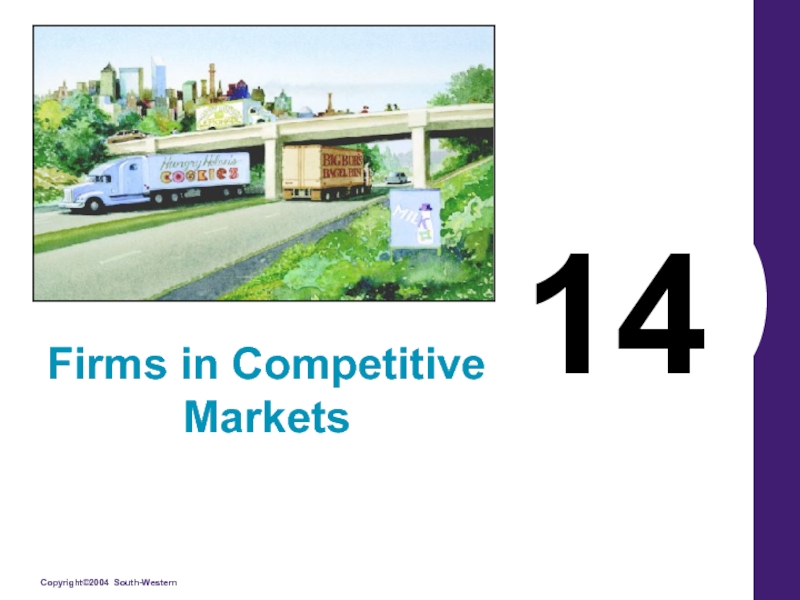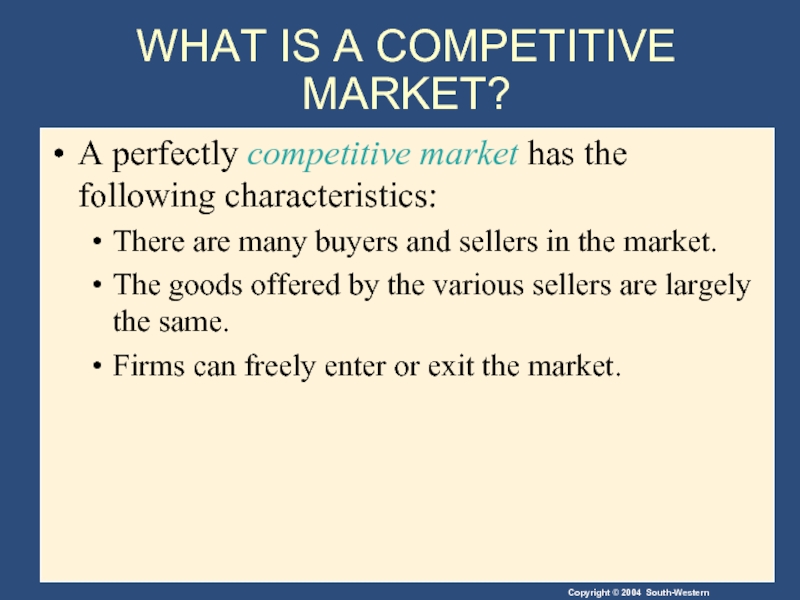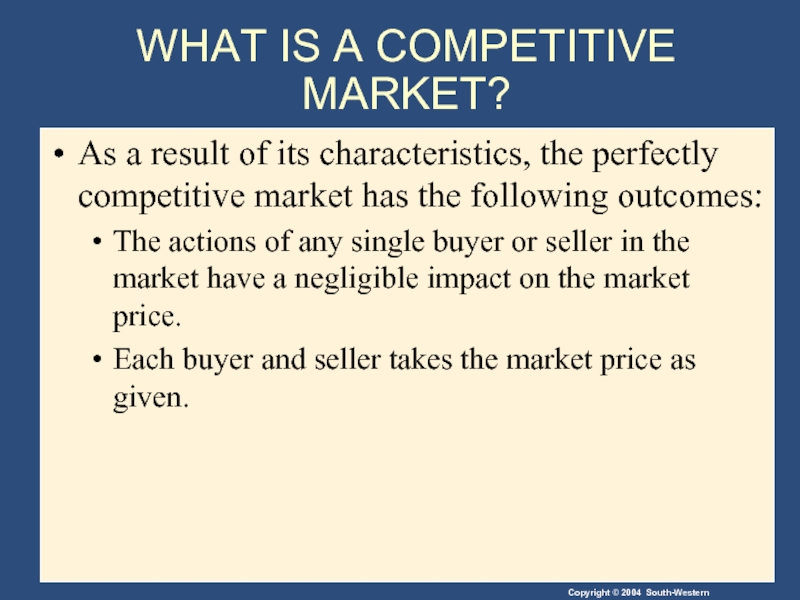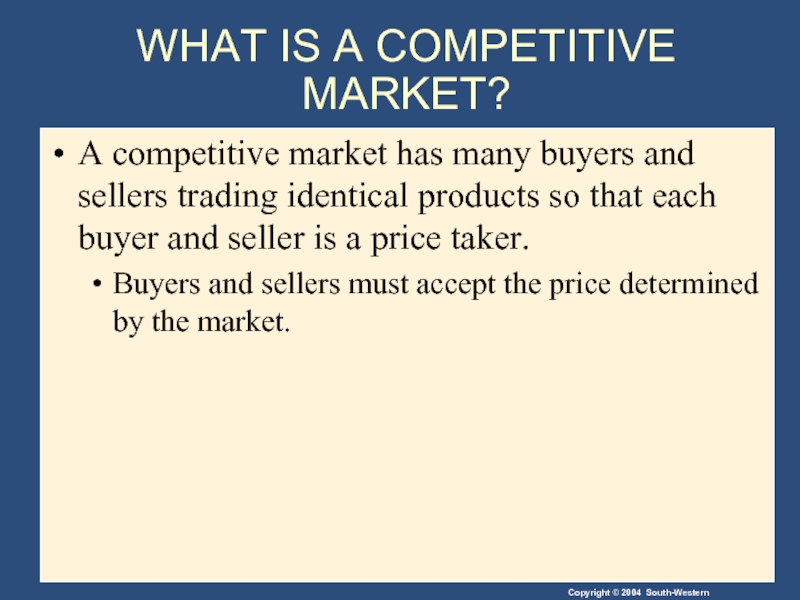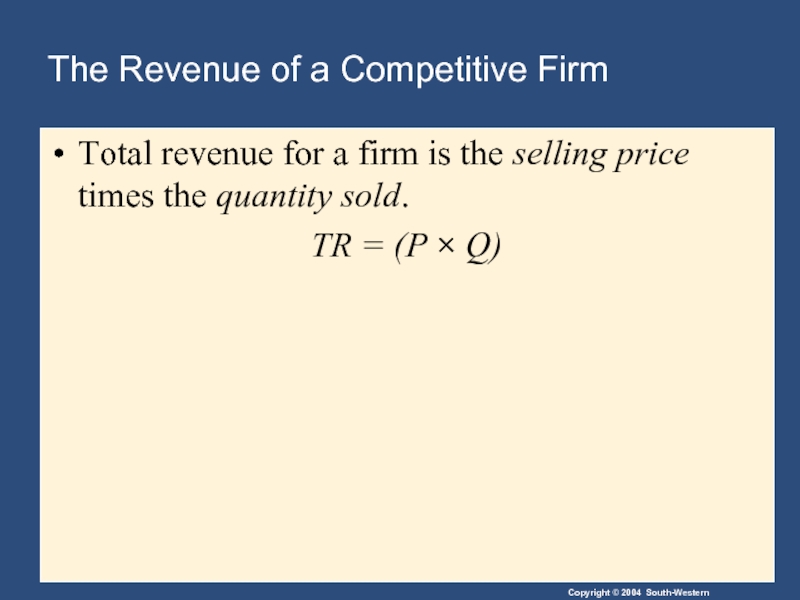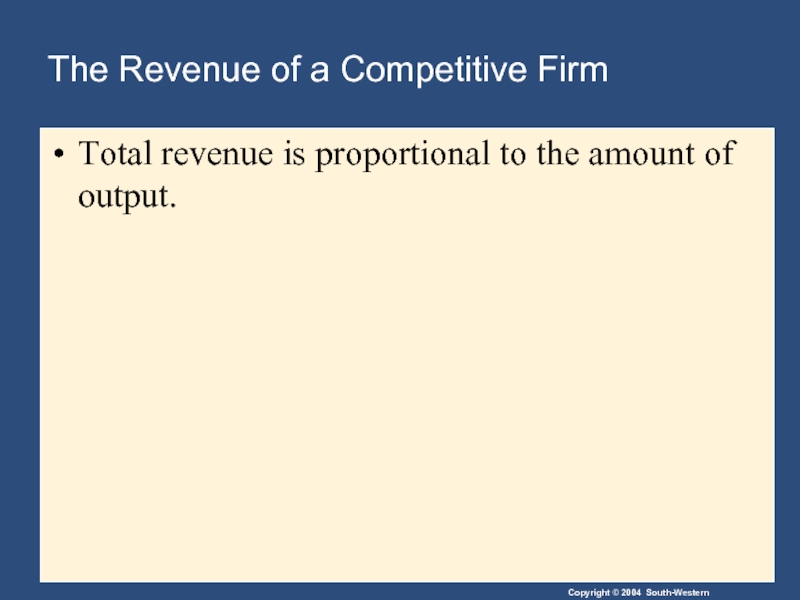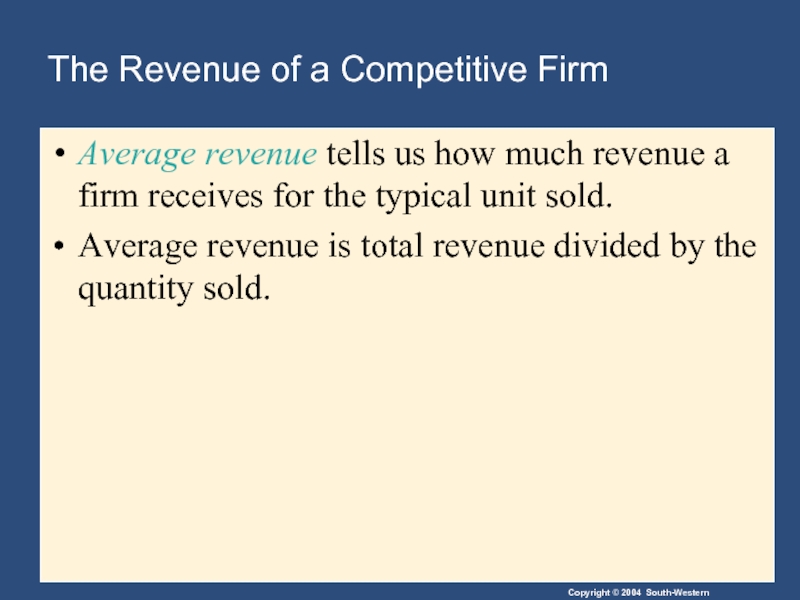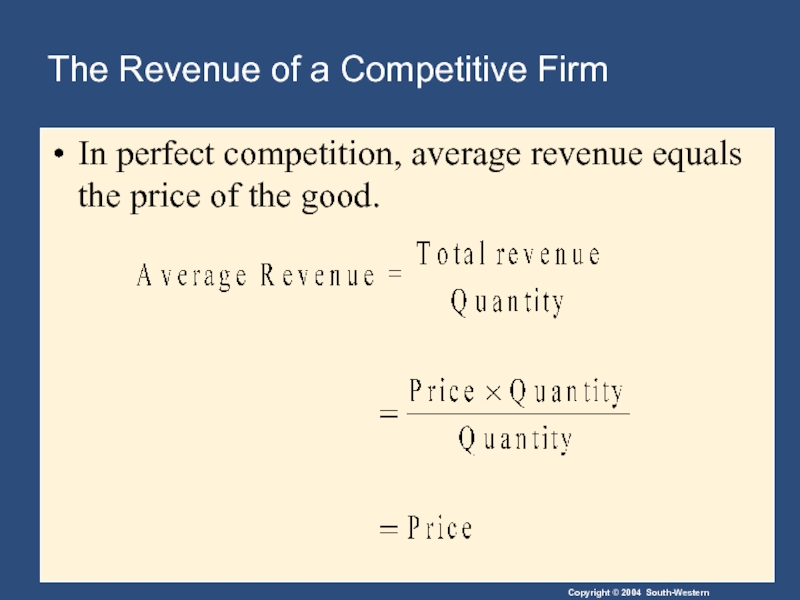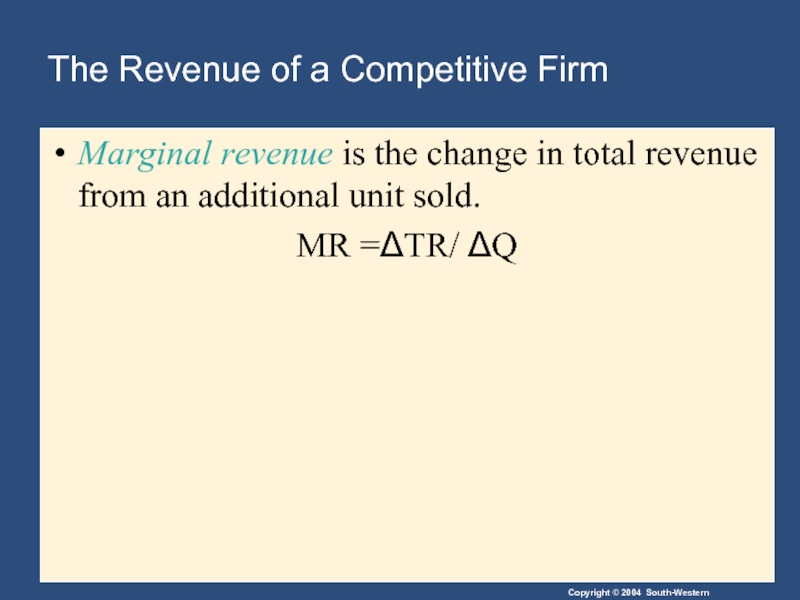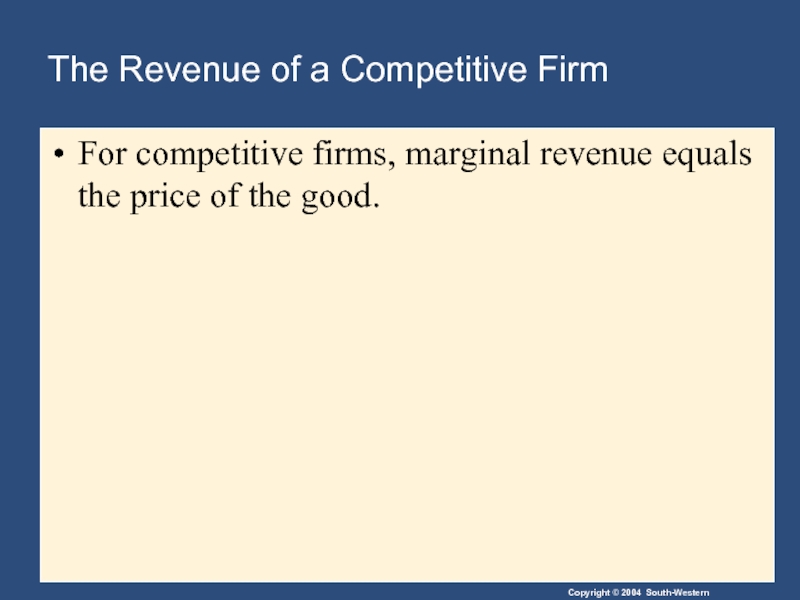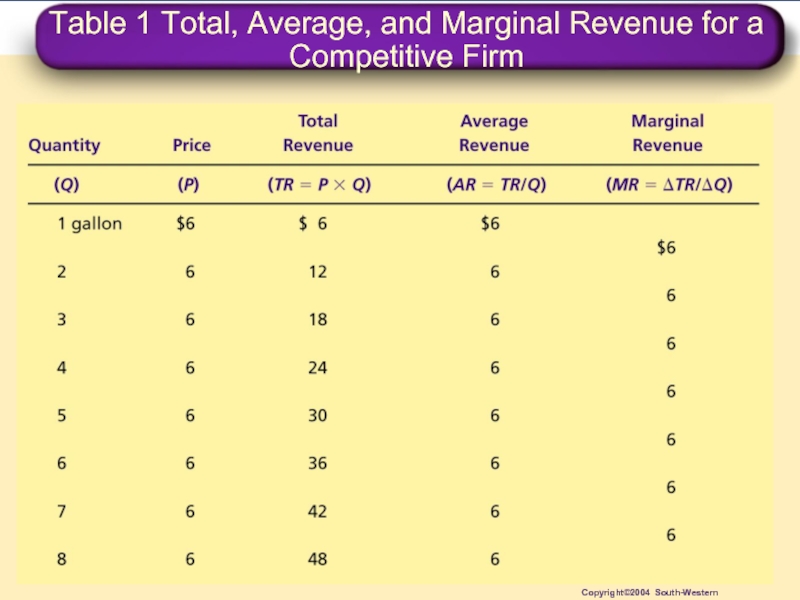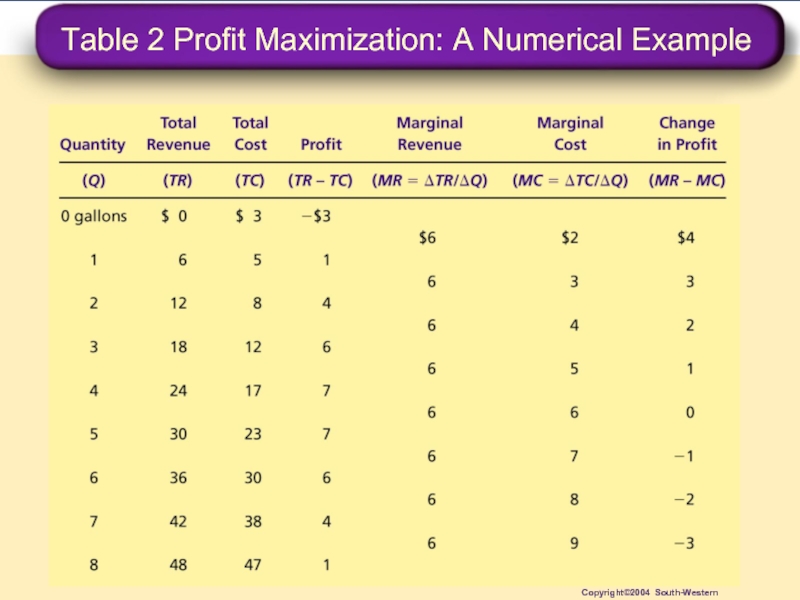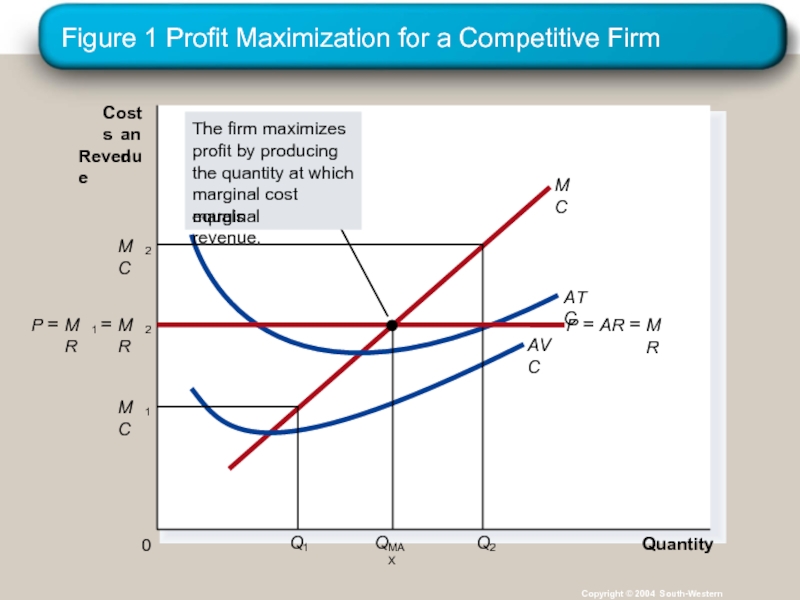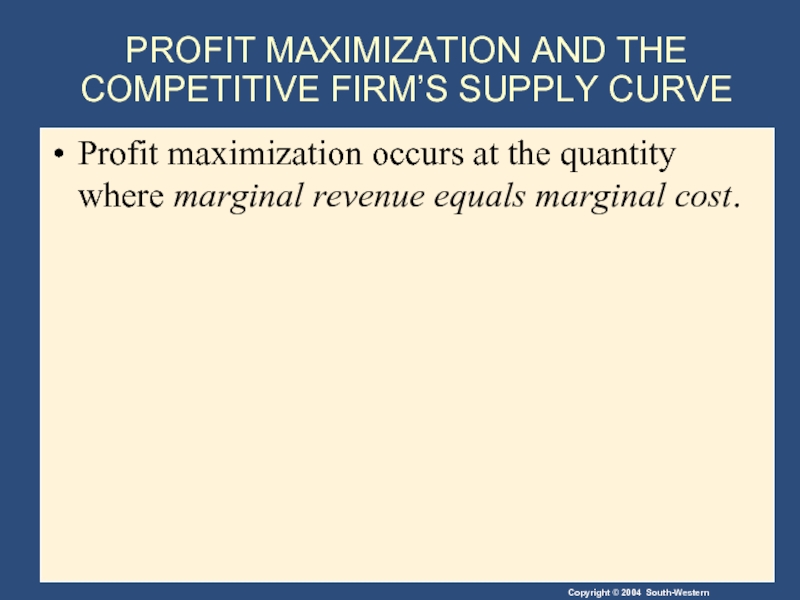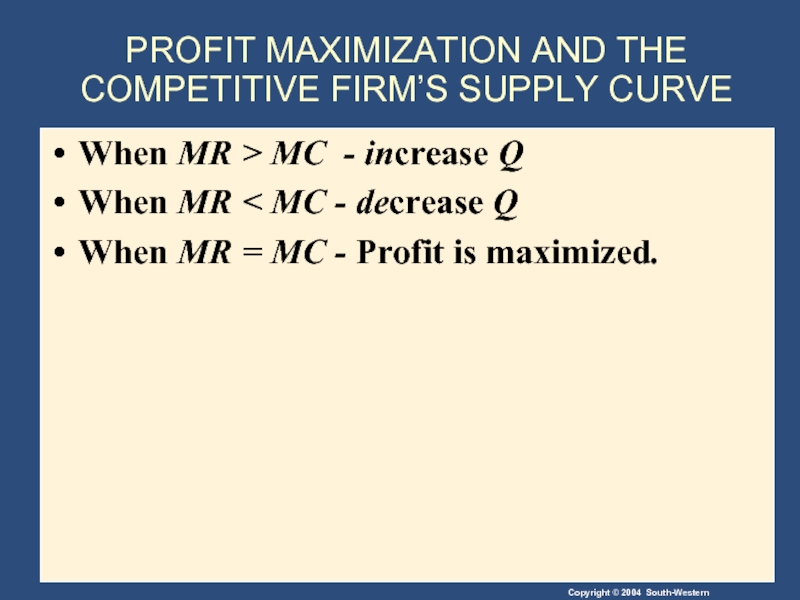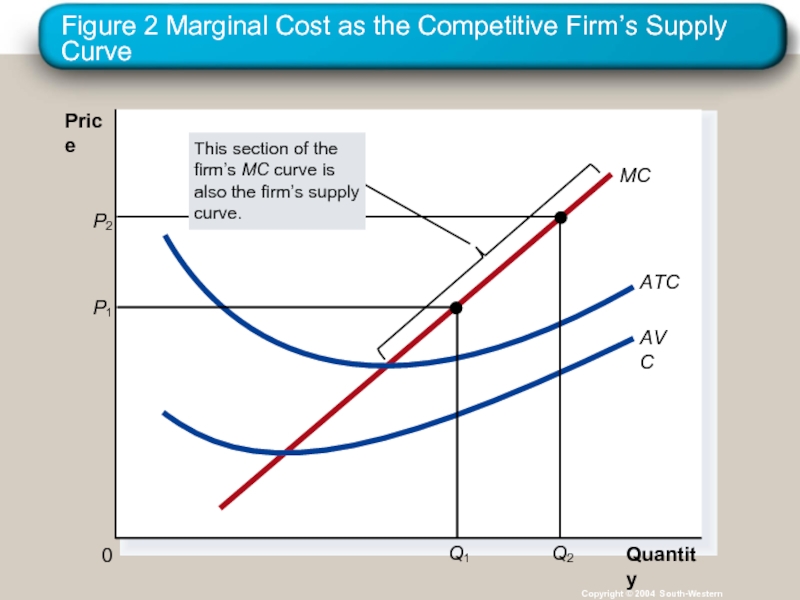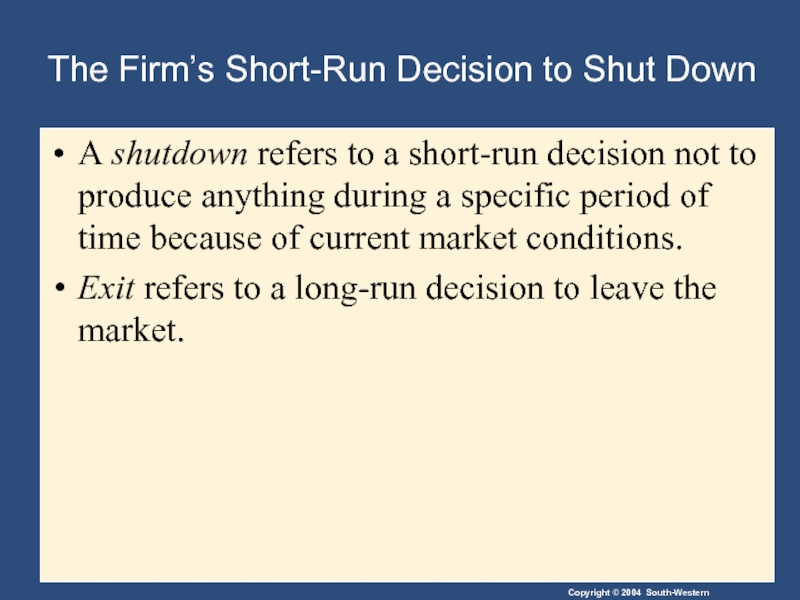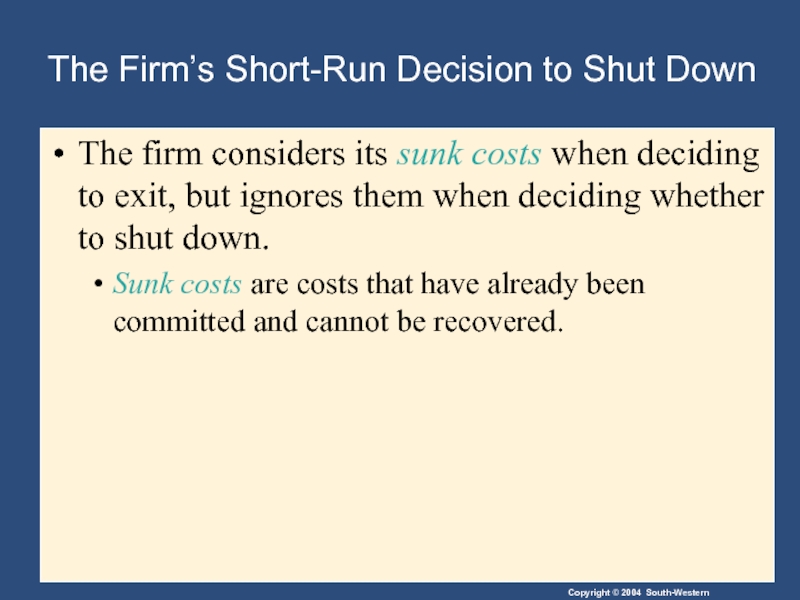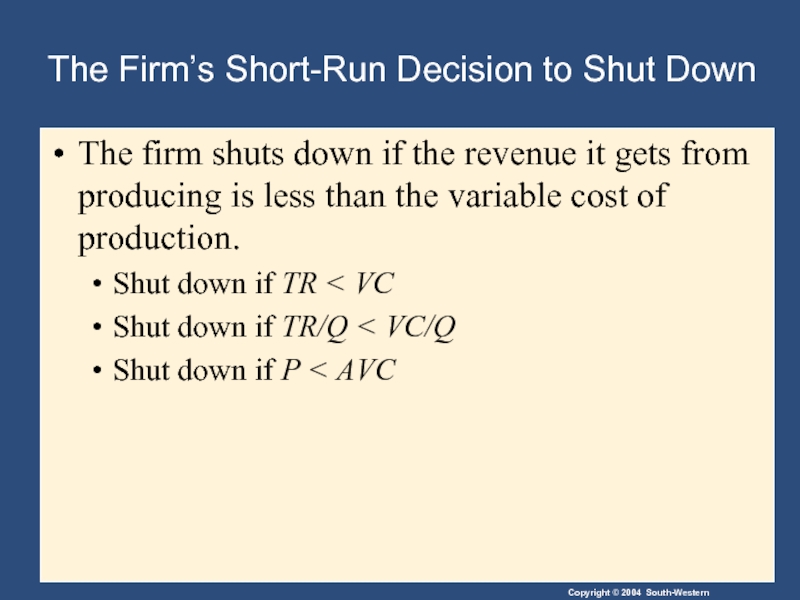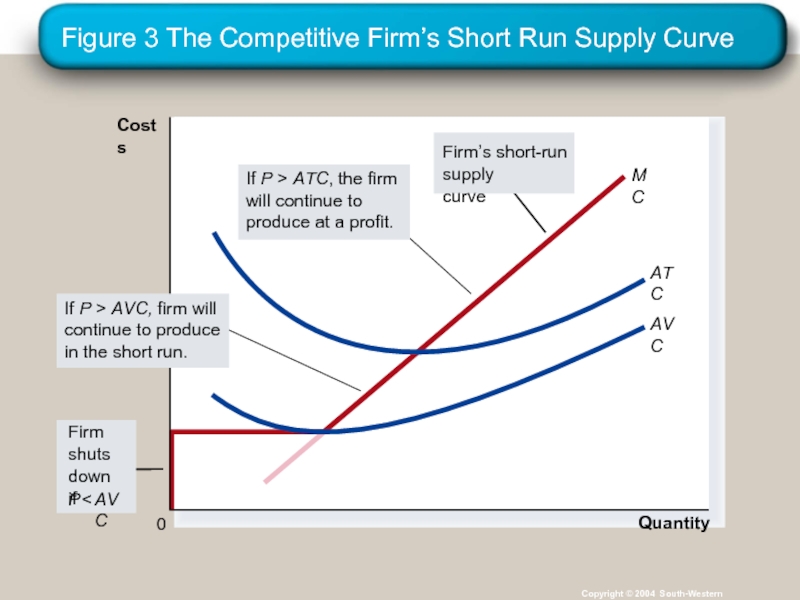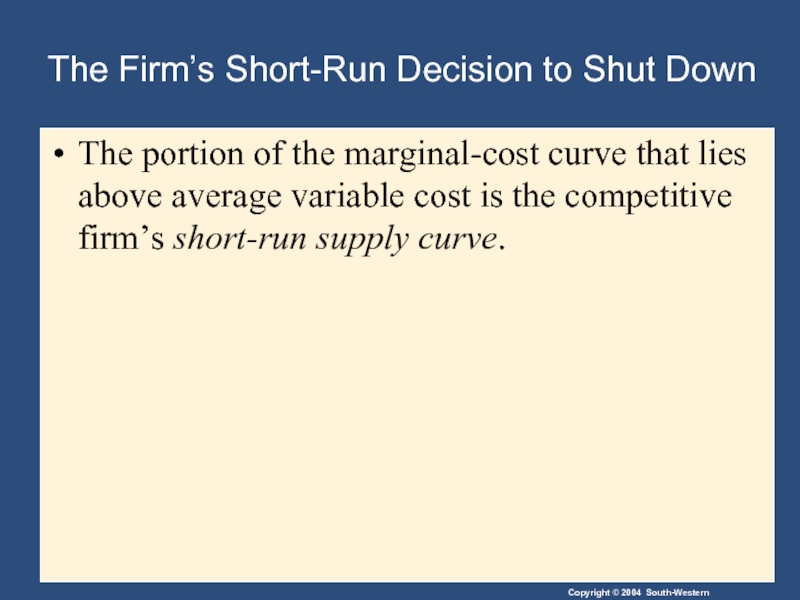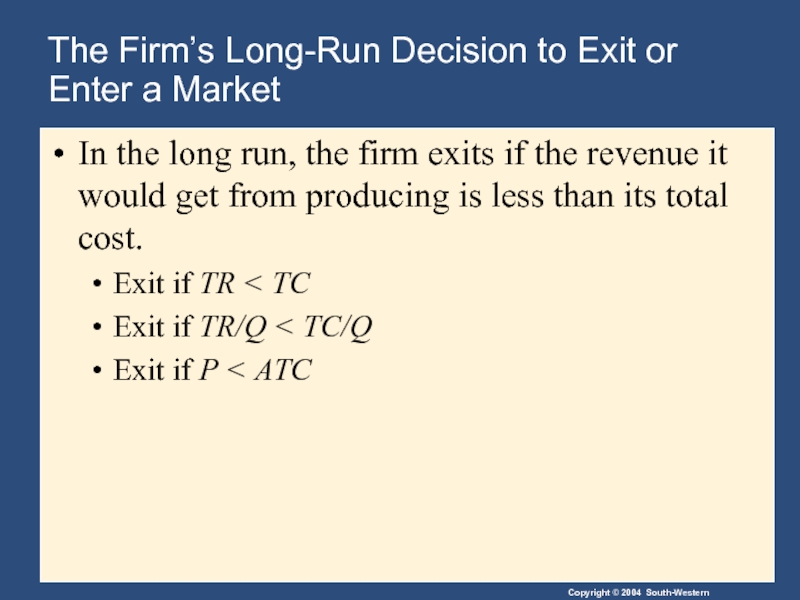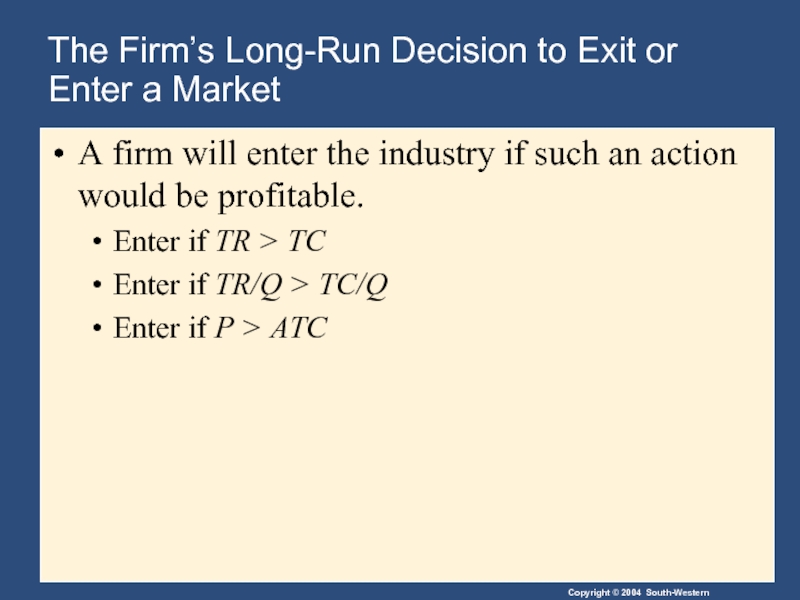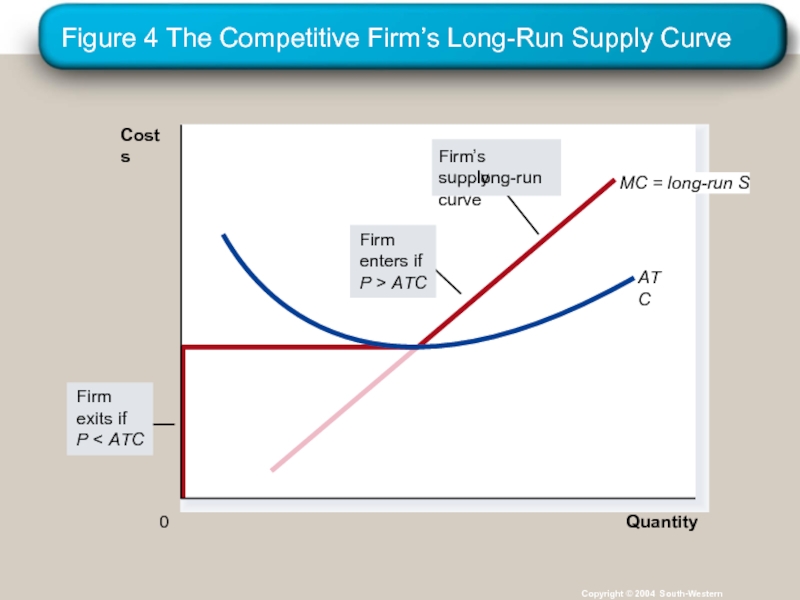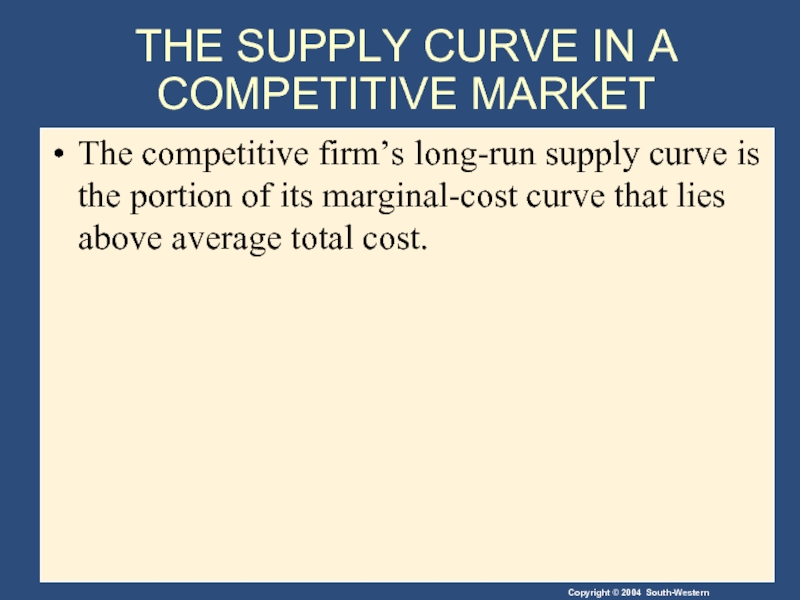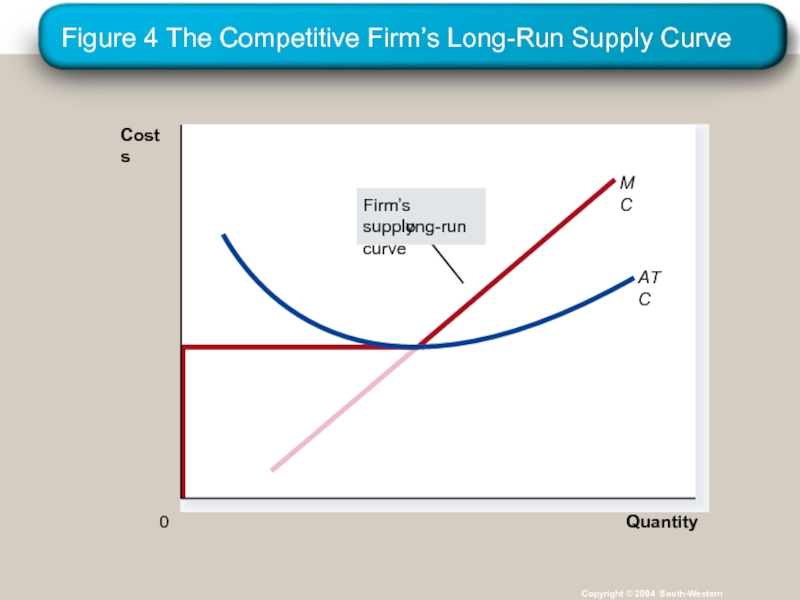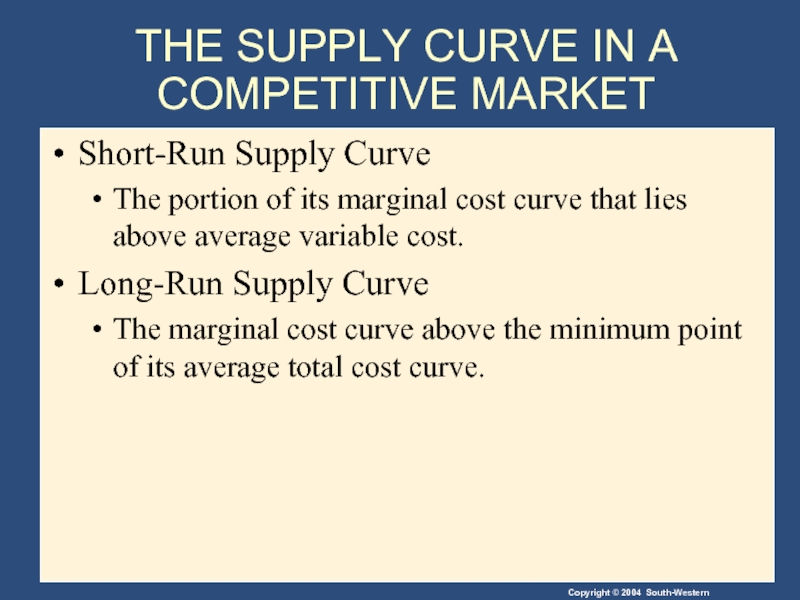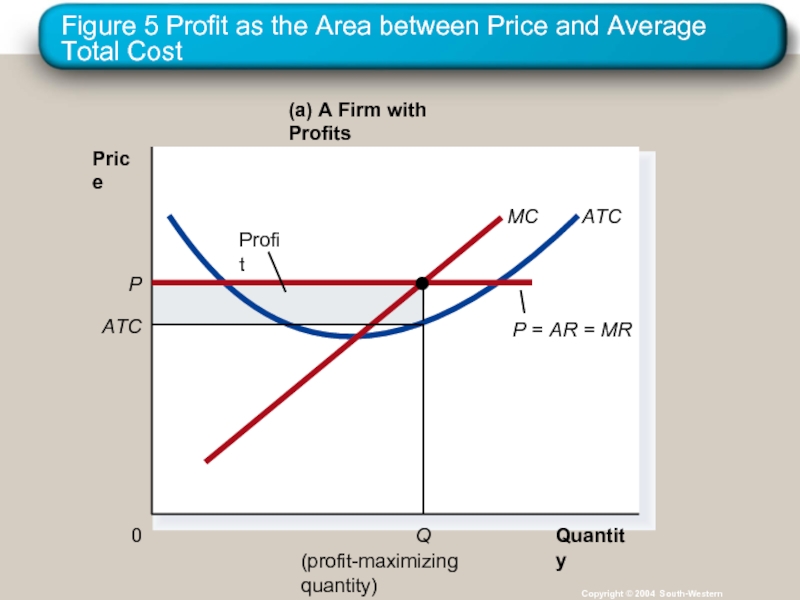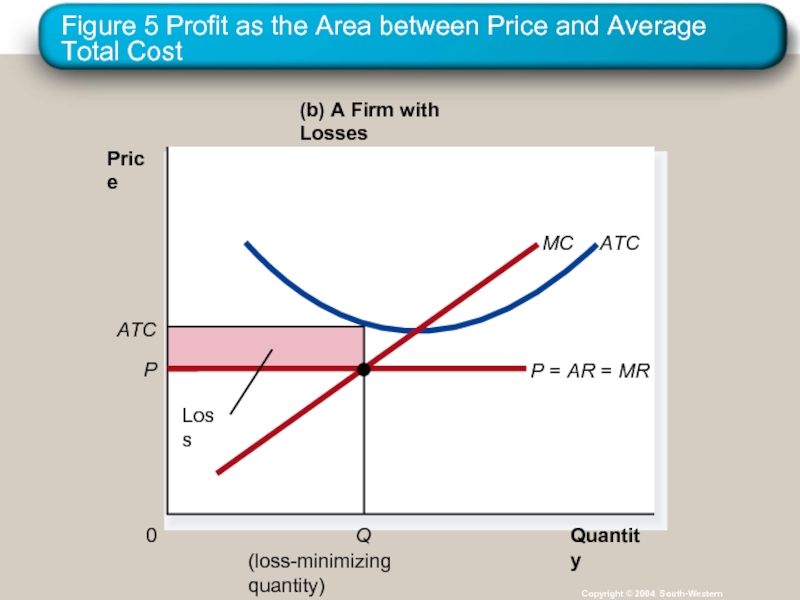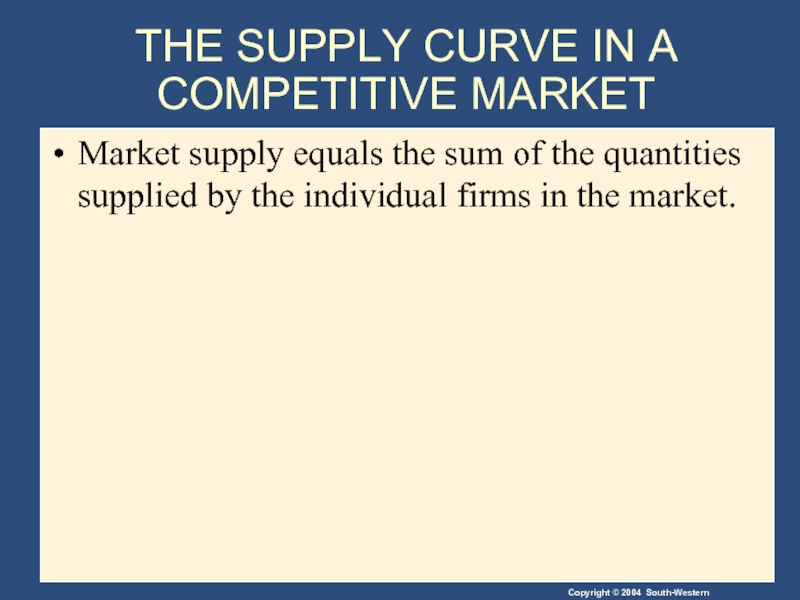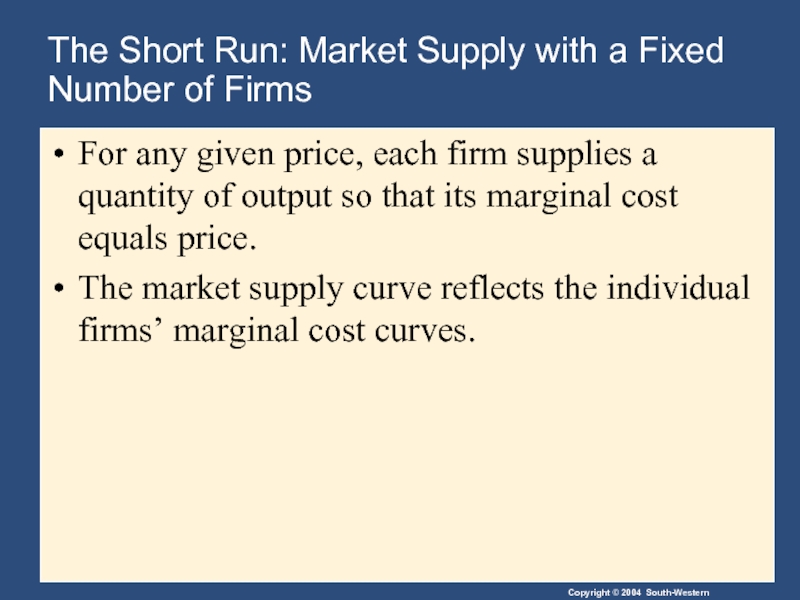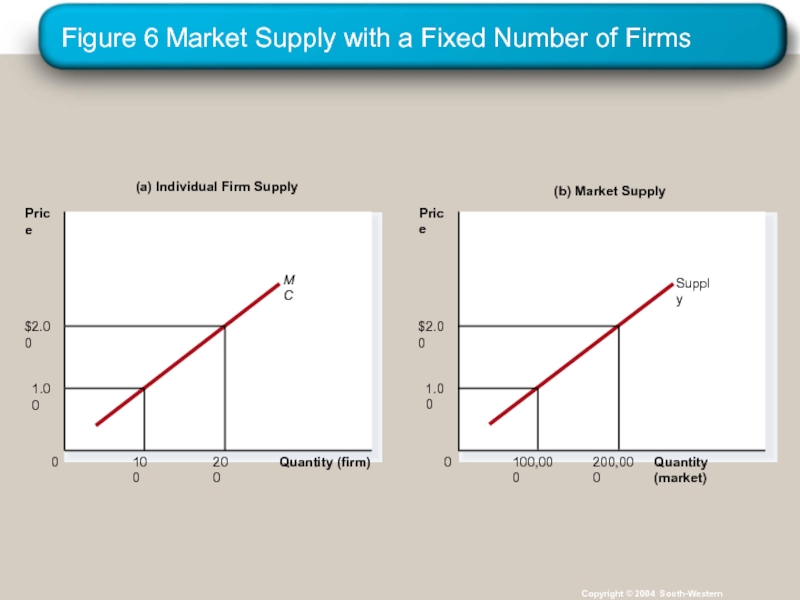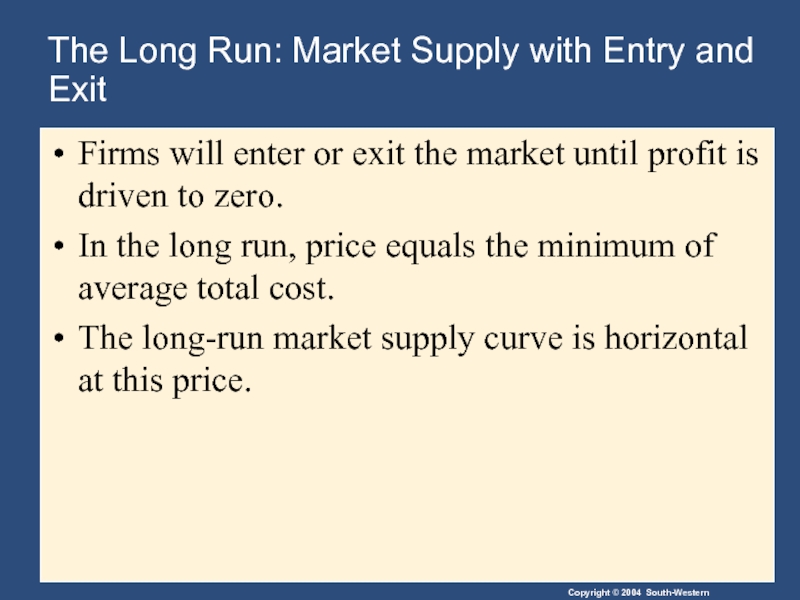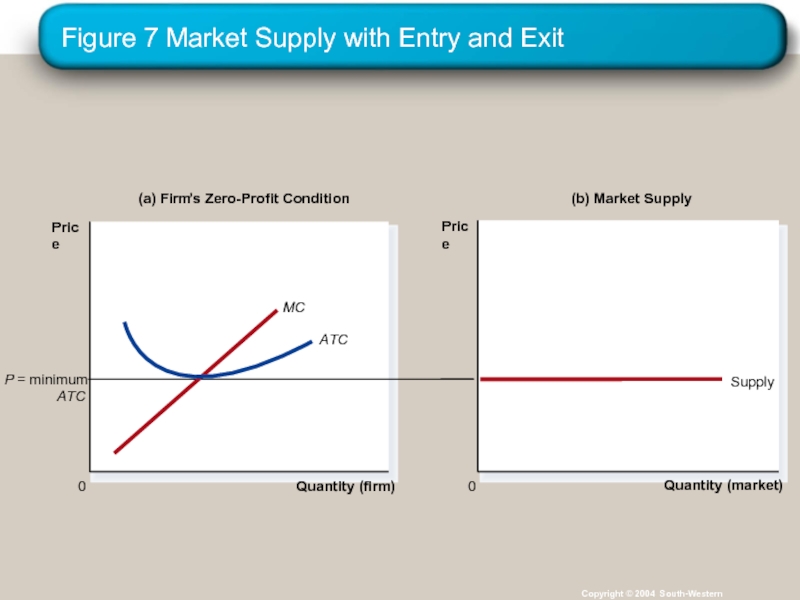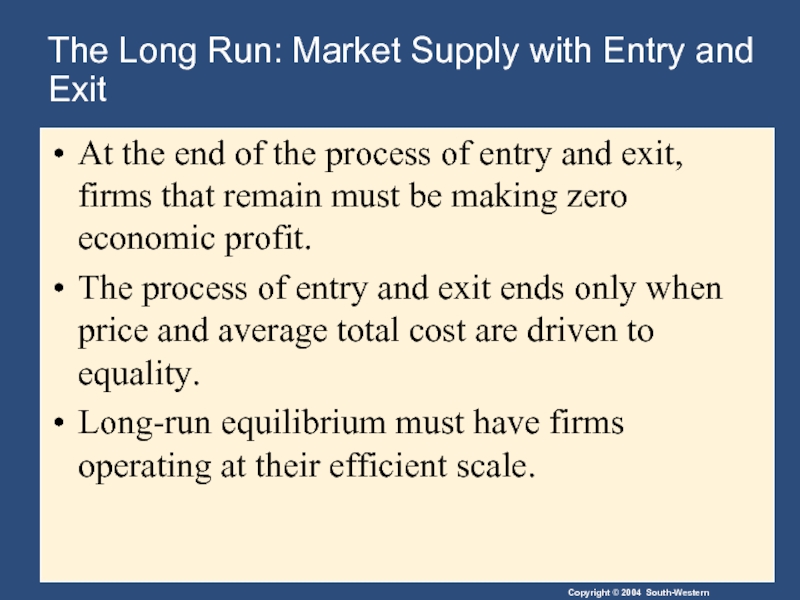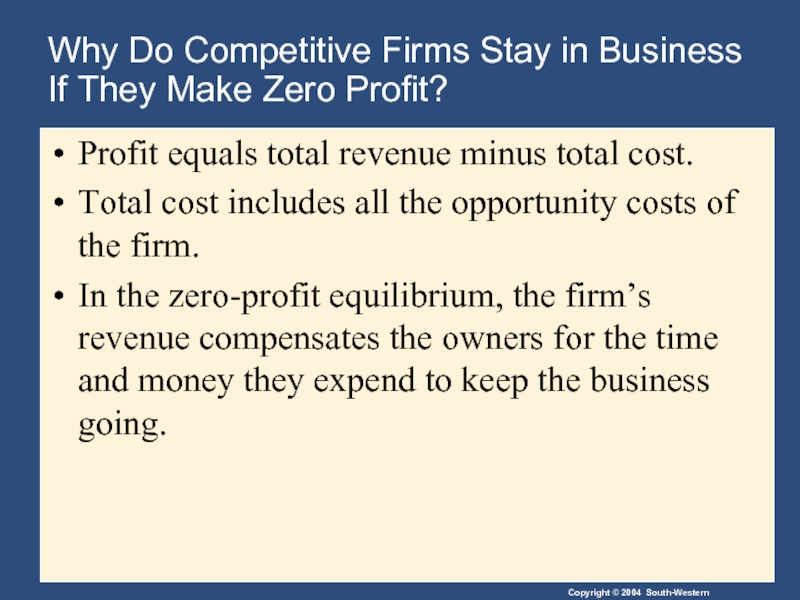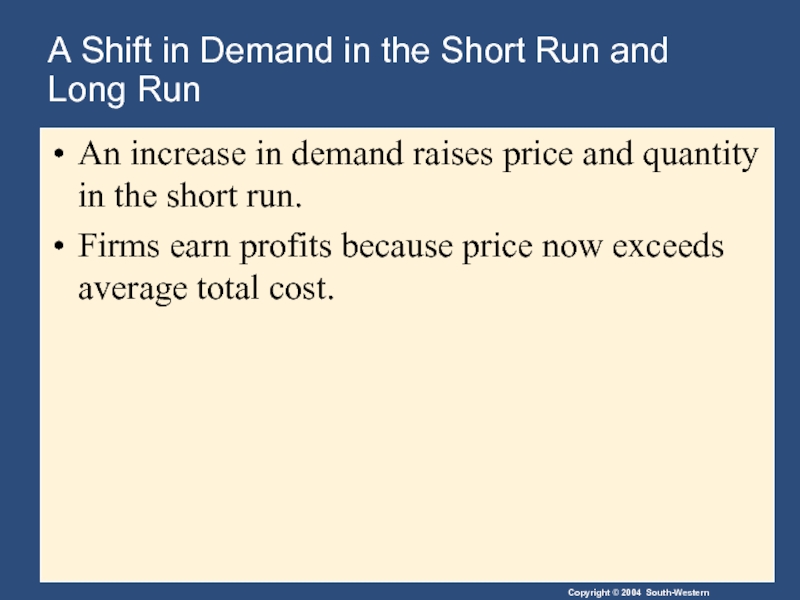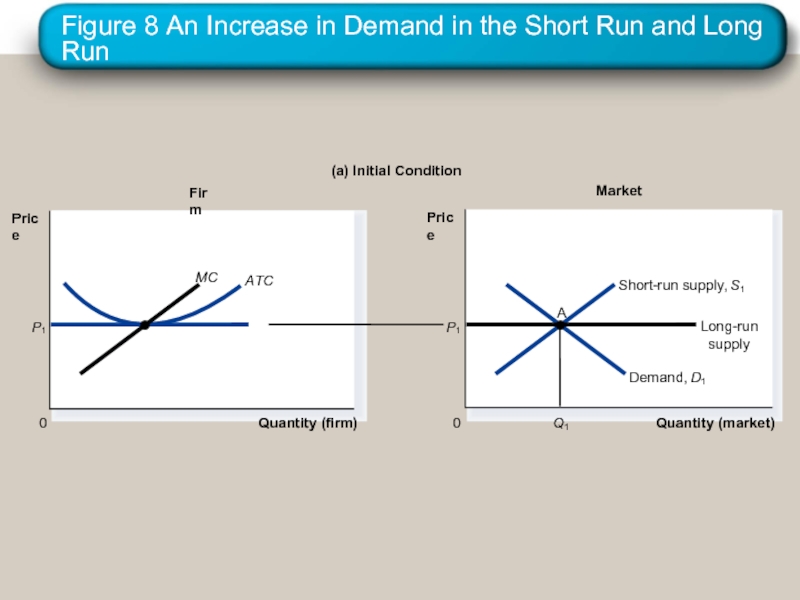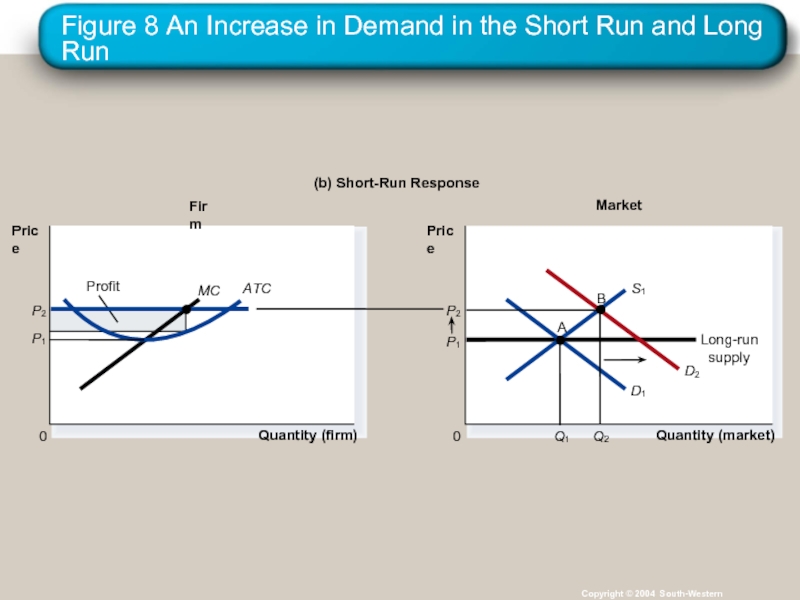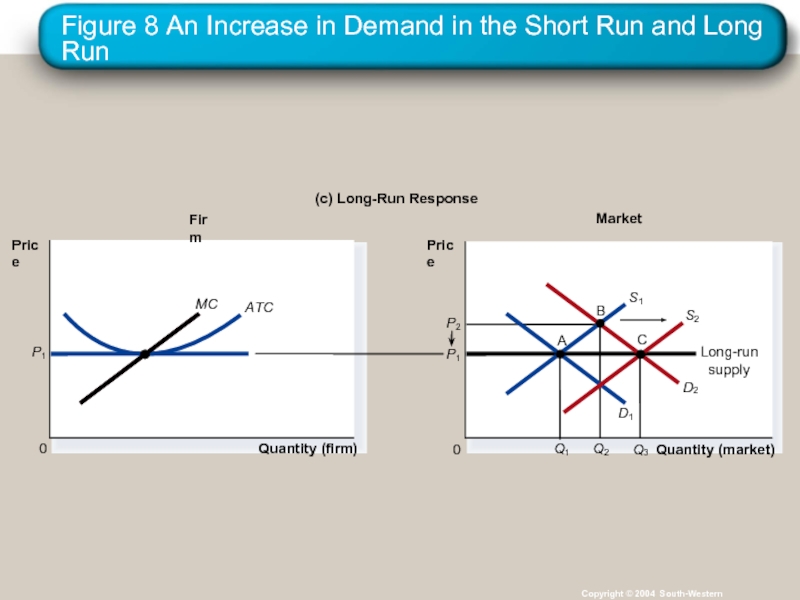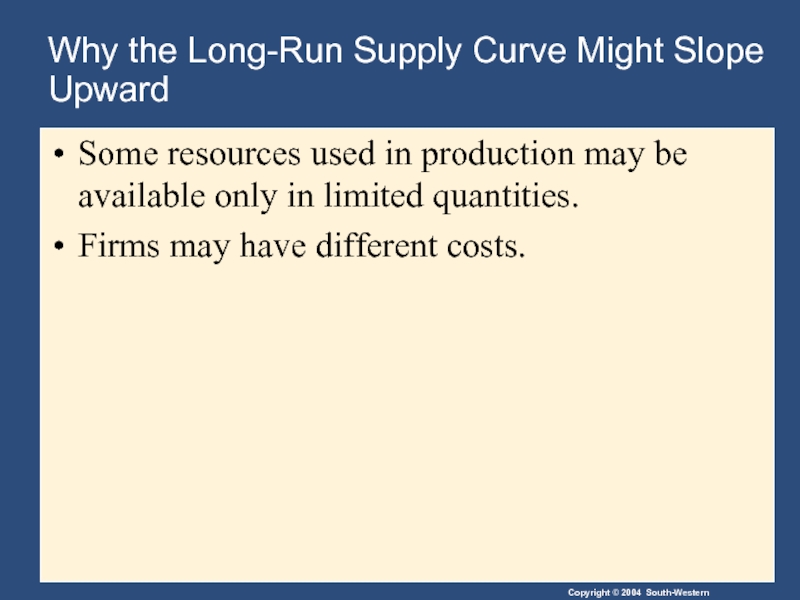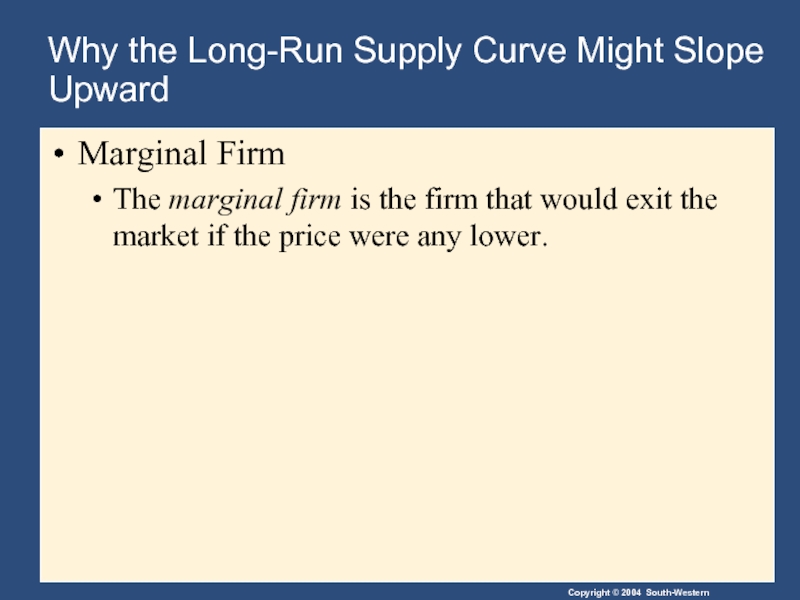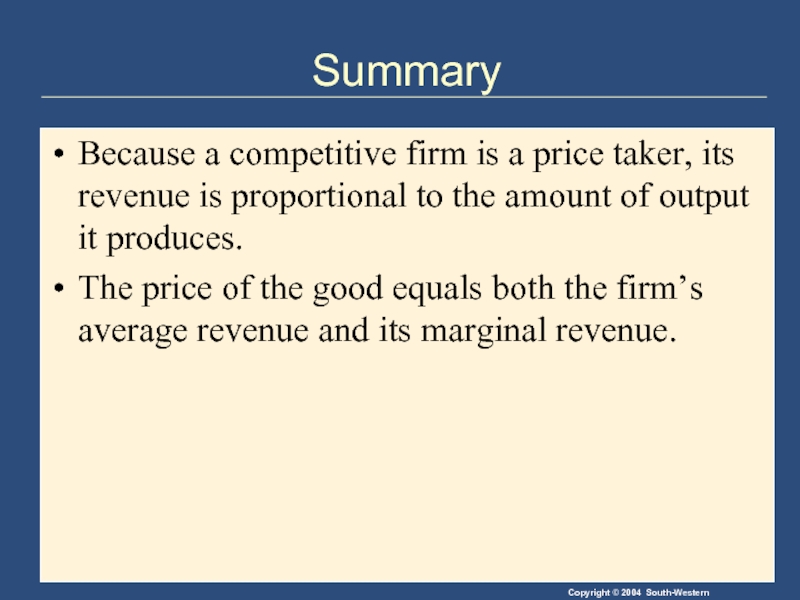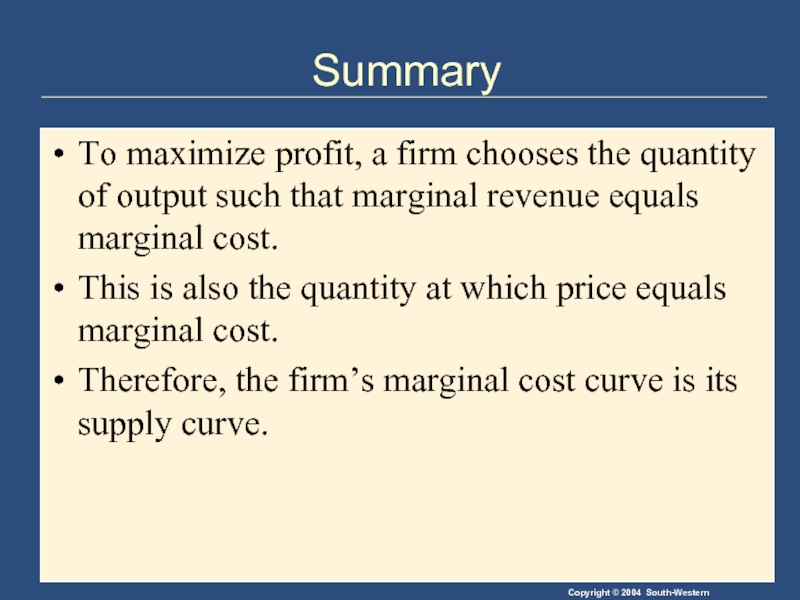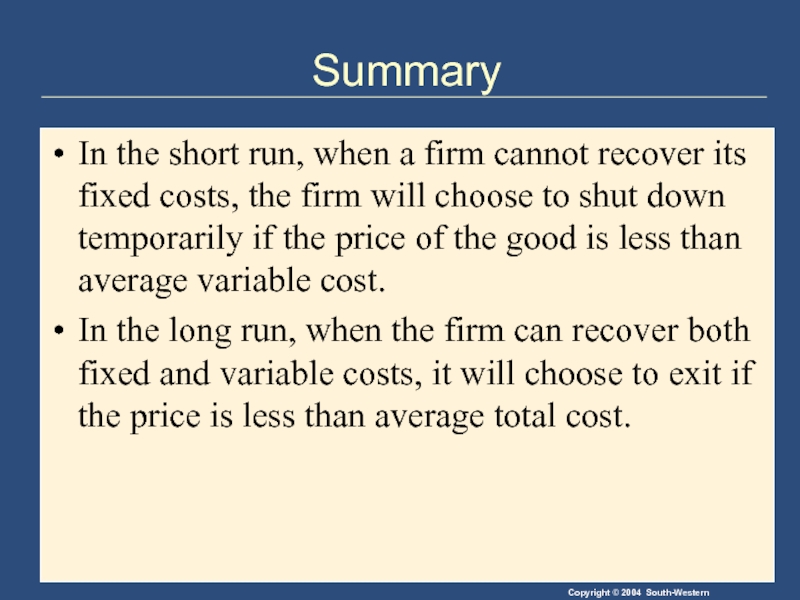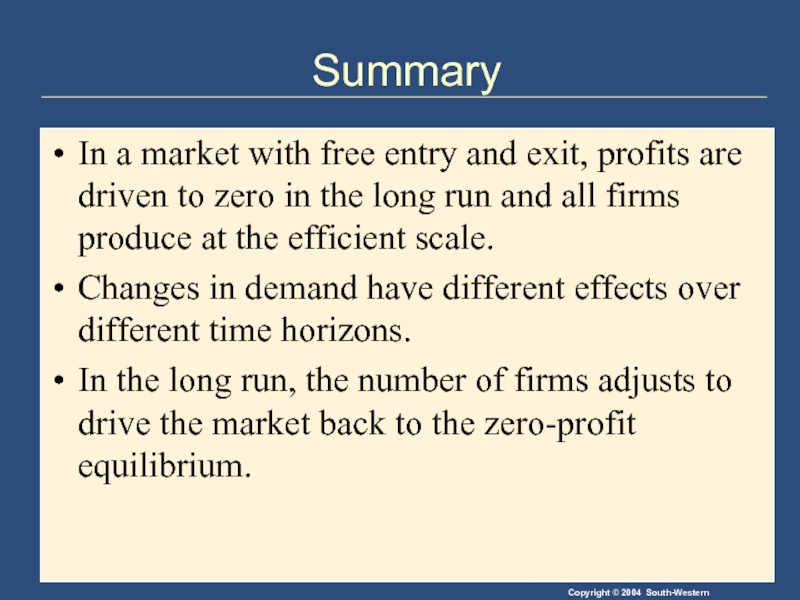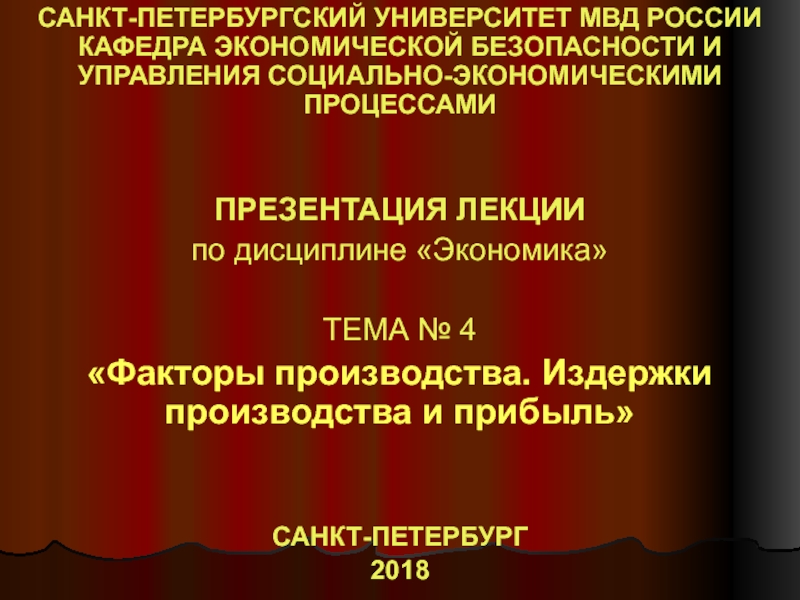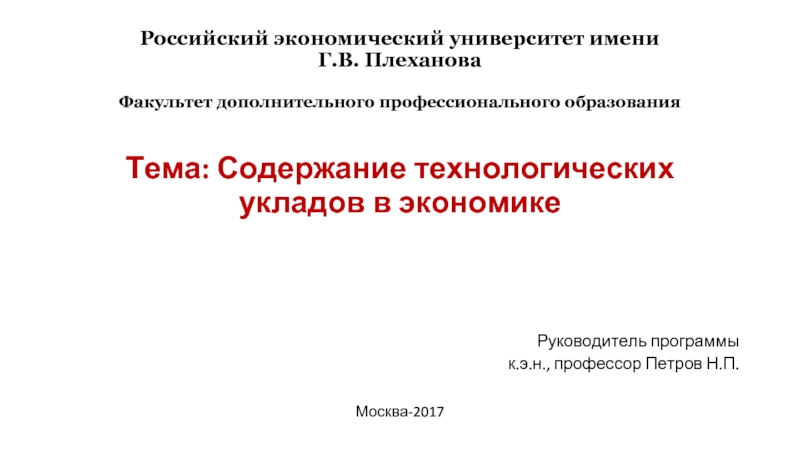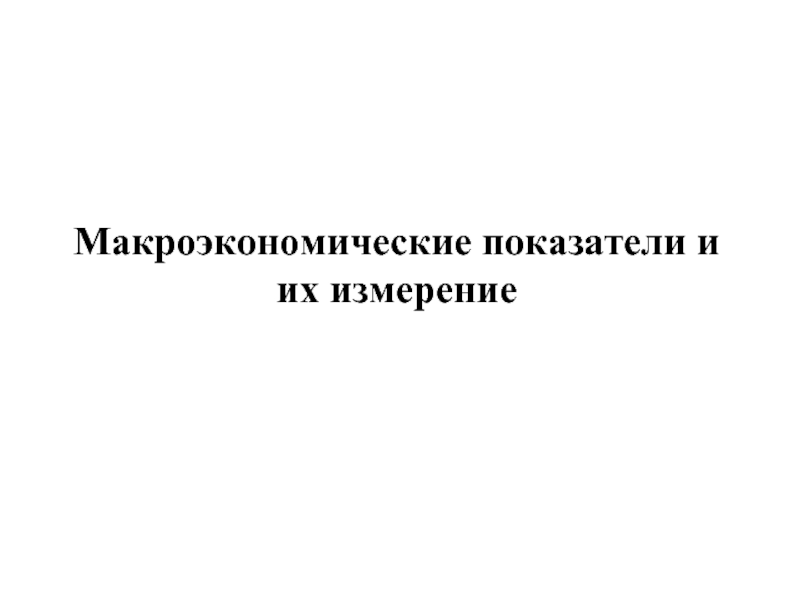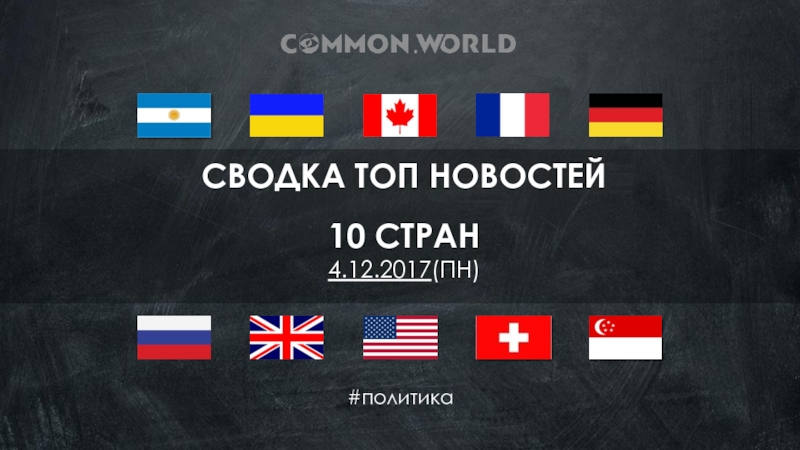- Главная
- Разное
- Дизайн
- Бизнес и предпринимательство
- Аналитика
- Образование
- Развлечения
- Красота и здоровье
- Финансы
- Государство
- Путешествия
- Спорт
- Недвижимость
- Армия
- Графика
- Культурология
- Еда и кулинария
- Лингвистика
- Английский язык
- Астрономия
- Алгебра
- Биология
- География
- Детские презентации
- Информатика
- История
- Литература
- Маркетинг
- Математика
- Медицина
- Менеджмент
- Музыка
- МХК
- Немецкий язык
- ОБЖ
- Обществознание
- Окружающий мир
- Педагогика
- Русский язык
- Технология
- Физика
- Философия
- Химия
- Шаблоны, картинки для презентаций
- Экология
- Экономика
- Юриспруденция
Firms in competitive markets. (Lecture 14) презентация
Содержание
- 1. Firms in competitive markets. (Lecture 14)
- 2. WHAT IS A COMPETITIVE MARKET? A perfectly
- 3. WHAT IS A COMPETITIVE MARKET? As a
- 4. WHAT IS A COMPETITIVE MARKET? A competitive
- 5. The Revenue of a Competitive Firm Total
- 6. The Revenue of a Competitive Firm Total revenue is proportional to the amount of output.
- 7. The Revenue of a Competitive Firm Average
- 8. The Revenue of a Competitive Firm In
- 9. The Revenue of a Competitive Firm Marginal
- 10. The Revenue of a Competitive Firm For
- 11. Table 1 Total, Average, and Marginal Revenue for a Competitive Firm Copyright©2004 South-Western
- 12. PROFIT MAXIMIZATION AND THE COMPETITIVE FIRM’S SUPPLY
- 13. Table 2 Profit Maximization: A Numerical Example Copyright©2004 South-Western
- 14. Figure 1 Profit Maximization for a Competitive
- 15. PROFIT MAXIMIZATION AND THE COMPETITIVE FIRM’S SUPPLY
- 16. PROFIT MAXIMIZATION AND THE COMPETITIVE FIRM’S SUPPLY
- 17. Figure 2 Marginal Cost as the Competitive
- 18. The Firm’s Short-Run Decision to Shut Down
- 19. The Firm’s Short-Run Decision to Shut Down
- 20. The Firm’s Short-Run Decision to Shut Down
- 21. Figure 3 The Competitive Firm’s Short Run
- 22. The Firm’s Short-Run Decision to Shut Down
- 23. The Firm’s Long-Run Decision to Exit or
- 24. The Firm’s Long-Run Decision to Exit or
- 25. Figure 4 The Competitive Firm’s Long-Run Supply
- 26. THE SUPPLY CURVE IN A COMPETITIVE MARKET
- 27. Figure 4 The Competitive Firm’s Long-Run Supply
- 28. THE SUPPLY CURVE IN A COMPETITIVE MARKET
- 29. Figure 5 Profit as the Area between
- 30. Figure 5 Profit as the Area between
- 31. THE SUPPLY CURVE IN A COMPETITIVE MARKET
- 32. The Short Run: Market Supply with a
- 33. Figure 6 Market Supply with a Fixed
- 34. The Long Run: Market Supply with Entry
- 35. Figure 7 Market Supply with Entry and
- 36. The Long Run: Market Supply with Entry
- 37. Why Do Competitive Firms Stay in Business
- 38. A Shift in Demand in the Short
- 39. Figure 8 An Increase in Demand in
- 40. Figure 8 An Increase in Demand in
- 41. Figure 8 An Increase in Demand in
- 42. Why the Long-Run Supply Curve Might Slope
- 43. Why the Long-Run Supply Curve Might Slope
- 44. Summary Because a competitive firm is a
- 45. Summary To maximize profit, a firm chooses
- 46. Summary In the short run, when a
- 47. Summary In a market with free entry
Слайд 2WHAT IS A COMPETITIVE MARKET?
A perfectly competitive market has the following
There are many buyers and sellers in the market.
The goods offered by the various sellers are largely the same.
Firms can freely enter or exit the market.
Слайд 3WHAT IS A COMPETITIVE MARKET?
As a result of its characteristics, the
The actions of any single buyer or seller in the market have a negligible impact on the market price.
Each buyer and seller takes the market price as given.
Слайд 4WHAT IS A COMPETITIVE MARKET?
A competitive market has many buyers and
Buyers and sellers must accept the price determined by the market.
Слайд 5The Revenue of a Competitive Firm
Total revenue for a firm is
TR = (P × Q)
Слайд 7The Revenue of a Competitive Firm
Average revenue tells us how much
Average revenue is total revenue divided by the quantity sold.
Слайд 8The Revenue of a Competitive Firm
In perfect competition, average revenue equals
Слайд 9The Revenue of a Competitive Firm
Marginal revenue is the change in
MR =ΔTR/ ΔQ
Слайд 10The Revenue of a Competitive Firm
For competitive firms, marginal revenue equals
Слайд 11Table 1 Total, Average, and Marginal Revenue for a Competitive Firm
Copyright©2004
Слайд 12PROFIT MAXIMIZATION AND THE COMPETITIVE FIRM’S SUPPLY CURVE
The goal of a
This means that the firm will want to produce the quantity that maximizes the difference between total revenue and total cost.
Слайд 14Figure 1 Profit Maximization for a Competitive Firm
Copyright © 2004 South-Western
Quantity
0
Costs
and
Revenue
Слайд 15PROFIT MAXIMIZATION AND THE COMPETITIVE FIRM’S SUPPLY CURVE
Profit maximization occurs at
Слайд 16PROFIT MAXIMIZATION AND THE COMPETITIVE FIRM’S SUPPLY CURVE
When MR > MC
When MR < MC - decrease Q
When MR = MC - Profit is maximized.
Слайд 17Figure 2 Marginal Cost as the Competitive Firm’s Supply Curve
Copyright ©
Quantity
0
Price
Слайд 18The Firm’s Short-Run Decision to Shut Down
A shutdown refers to a
Exit refers to a long-run decision to leave the market.
Слайд 19The Firm’s Short-Run Decision to Shut Down
The firm considers its sunk
Sunk costs are costs that have already been committed and cannot be recovered.
Слайд 20The Firm’s Short-Run Decision to Shut Down
The firm shuts down if
Shut down if TR < VC
Shut down if TR/Q < VC/Q
Shut down if P < AVC
Слайд 21Figure 3 The Competitive Firm’s Short Run Supply Curve
Copyright © 2004
Quantity
0
Costs
Слайд 22The Firm’s Short-Run Decision to Shut Down
The portion of the marginal-cost
Слайд 23The Firm’s Long-Run Decision to Exit or Enter a Market
In the
Exit if TR < TC
Exit if TR/Q < TC/Q
Exit if P < ATC
Слайд 24The Firm’s Long-Run Decision to Exit or Enter a Market
A firm
Enter if TR > TC
Enter if TR/Q > TC/Q
Enter if P > ATC
Слайд 25Figure 4 The Competitive Firm’s Long-Run Supply Curve
Copyright © 2004 South-Western
Quantity
0
Costs
Слайд 26THE SUPPLY CURVE IN A COMPETITIVE MARKET
The competitive firm’s long-run supply
Слайд 27Figure 4 The Competitive Firm’s Long-Run Supply Curve
Copyright © 2004 South-Western
Quantity
0
Costs
Слайд 28THE SUPPLY CURVE IN A COMPETITIVE MARKET
Short-Run Supply Curve
The portion of
Long-Run Supply Curve
The marginal cost curve above the minimum point of its average total cost curve.
Слайд 29Figure 5 Profit as the Area between Price and Average Total
Copyright © 2004 South-Western
(a) A Firm with Profits
Quantity
0
Price
(profit-maximizing quantity)
Слайд 30Figure 5 Profit as the Area between Price and Average Total
Copyright © 2004 South-Western
(b) A Firm with Losses
Quantity
0
Price
(loss-minimizing quantity)
Слайд 31THE SUPPLY CURVE IN A COMPETITIVE MARKET
Market supply equals the sum
Слайд 32The Short Run: Market Supply with a Fixed Number of Firms
For
The market supply curve reflects the individual firms’ marginal cost curves.
Слайд 33Figure 6 Market Supply with a Fixed Number of Firms
Copyright ©
(a) Individual Firm Supply
Quantity (firm)
0
Price
(b) Market Supply
Quantity (market)
0
Price
Слайд 34The Long Run: Market Supply with Entry and Exit
Firms will enter
In the long run, price equals the minimum of average total cost.
The long-run market supply curve is horizontal at this price.
Слайд 35Figure 7 Market Supply with Entry and Exit
Copyright © 2004 South-Western
(a)
’
s Zero-Profit Condition
Quantity (firm)
0
Price
(b) Market Supply
Quantity (market)
Price
0
Слайд 36The Long Run: Market Supply with Entry and Exit
At the end
The process of entry and exit ends only when price and average total cost are driven to equality.
Long-run equilibrium must have firms operating at their efficient scale.
Слайд 37Why Do Competitive Firms Stay in Business If They Make Zero
Profit equals total revenue minus total cost.
Total cost includes all the opportunity costs of the firm.
In the zero-profit equilibrium, the firm’s revenue compensates the owners for the time and money they expend to keep the business going.
Слайд 38A Shift in Demand in the Short Run and
Long Run
An
Firms earn profits because price now exceeds average total cost.
Слайд 39Figure 8 An Increase in Demand in the Short Run and
Firm
(a) Initial Condition
Quantity (firm)
0
Price
Market
Quantity (market)
Price
0
Слайд 40Figure 8 An Increase in Demand in the Short Run and
Copyright © 2004 South-Western
Market
Firm
(b) Short-Run Response
Quantity (firm)
0
Price
Quantity (market)
Long-run
supply
Price
0
P
1
Слайд 41Figure 8 An Increase in Demand in the Short Run and
Copyright © 2004 South-Western
P
1
Firm
(c) Long-Run Response
Quantity (firm)
0
Price
MC
ATC
Market
Quantity (market)
Price
0
P
1
P
2
Q
1
Q
2
Long-run
supply
B
D
1
S
1
A
Слайд 42Why the Long-Run Supply Curve Might Slope Upward
Some resources used in
Firms may have different costs.
Слайд 43Why the Long-Run Supply Curve Might Slope Upward
Marginal Firm
The marginal
Слайд 44Summary
Because a competitive firm is a price taker, its revenue is
The price of the good equals both the firm’s average revenue and its marginal revenue.
Слайд 45Summary
To maximize profit, a firm chooses the quantity of output such
This is also the quantity at which price equals marginal cost.
Therefore, the firm’s marginal cost curve is its supply curve.
Слайд 46Summary
In the short run, when a firm cannot recover its fixed
In the long run, when the firm can recover both fixed and variable costs, it will choose to exit if the price is less than average total cost.
Слайд 47Summary
In a market with free entry and exit, profits are driven
Changes in demand have different effects over different time horizons.
In the long run, the number of firms adjusts to drive the market back to the zero-profit equilibrium.
